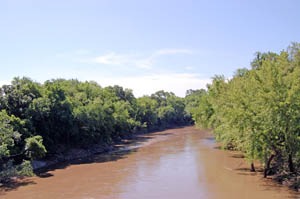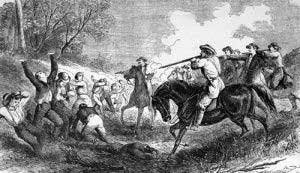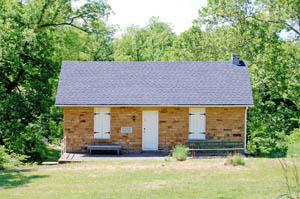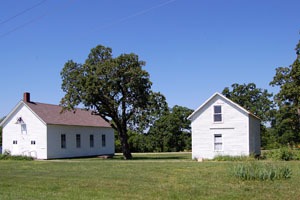Trading Post, Kansas, the first permanent white settlement in Linn County and one of the first in the state is situated on the Marais des Cygnes River. Though filled with history, the community is a ghost town today.

Marais des Cygnes River near Pleasanton by Kathy Alexander.
In 1825, Cyprian Chouteau, a trader from Missouri, received a license to trade with certain Indian tribes west of the Missouri River. He immediately established a trading post near the river and did extensive trade with the natives. As there were no roads then, his goods were transported through the woods on the backs of pack horses. The place was then called the Chouteau Trading Post.
Soon after Kansas Territory was organized, several pro-slavery men from Missouri settled near the trading post, which became their headquarters and the rendezvous point of a number of the border ruffians. The leader of the pro-slavery party was Charles A. Hamilton. A store was the only business in the settlement, and when a post office was established on September 2, 1857, the settlement was called Blooming Grove. The same year, a flour mill was erected, and in 1858, Dr. Massey and a man named White opened a second store near the bridge. Religious services were held outdoors.

Marais des Cygnes Massacre, Kansas
When the Missourians warned the Free-State settlers to leave the county, Colonel James Montgomery raided Trading Post to break up Hamilton’s headquarters. They did not kill or harm anyone but poured out all the whiskey found in the store and warned the pro-slavery settlers to leave, saying that there was no room for both in the county. As a result of this raid, Hamilton led the party that committed the Marais des Cygnes Massacre on the morning of May 19, 1858. At this time, Hamilton and some 30 other men rode through the village, captured 11 free-state men, and marched them into a deep ravine where they opened fire upon them. Five men were killed, five were seriously injured, and one escaped unharmed.
The community quickly came together and tried to render aid after finding the victims. As word spread, Montgomery’s Jayhawkers pursued Hamilton to no avail. A few weeks after the massacre, John Brown arrived and built a two-story log fort, about 14 x 18 feet, which he occupied with a few men through the summer. In December, he raided into Missouri, where 11 slaves were liberated, and one man was killed.
The land was later sold to Brown’s friend Charles C. Hadsall, who agreed to let Brown occupy it for military purposes. Brown and his men withdrew at the end of the summer, leaving the fort to Hadsall, who later built a stone house adjoining the site of Brown’s fort.
In October 1865, a townsite was platted just east of the site of the old trading post by the Montgomery Town Company. However, it was not successful and was soon abandoned.
The following year, another townsite was laid out by Dr. Massey and George A. Crawford. A two-story frame schoolhouse was built by the Masons in 1865. The 1857 grist mill was purchased and improved by J. & A. Brockett. A sawmill was attached to the two-and-a-half-story mill powered by water and steam. The town’s name and the post office were changed to Trading Post on June 22, 1880. At that time, the community boasted three general stores, a drug store, two blacksmith shops, an agricultural implement dealer, and about 100 residents.
Trading Post continued to flourish through the early 20th century. However, its post office closed on August 30, 1902, when it received its mail from Boicourt. In 1910, it still had a population of 146 and several stores. However, in the following years, it would continue to decline.
The Marais des Cygnes Massacres site was added to the National Register of Historic Places in 1971 and as a National Historic Landmark in 1974. In 1888, a monument honoring Marais des Cygnes Massacre victims was erected.
The Trading Post museum complex, located beside the cemetery, houses many exhibits, from the Osage Indians to the growth and decline of the town.
Trading Post is located about six miles north of Pleasanton.
©Kathy Alexander/Legends of Kansas, updated September 2023.
Also See:
Sources:
Blackmar, Frank W.; Kansas: A Cyclopedia of State History, Standard Publishing Company, 1912.
Cutler, William G.; Kansas: History of the State of Kansas, 1883.
Kansas Historical Society




